|
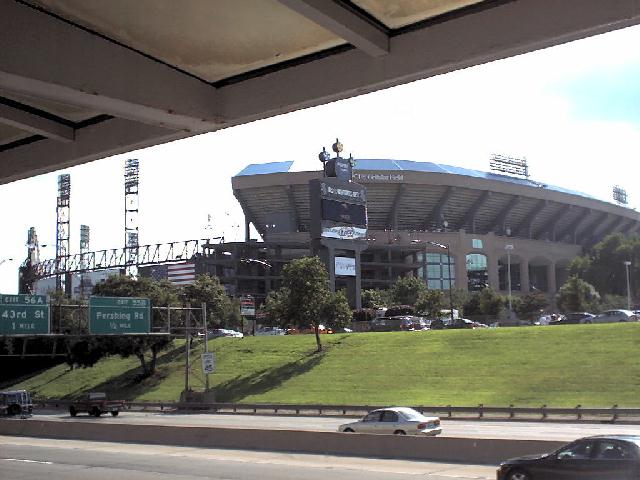
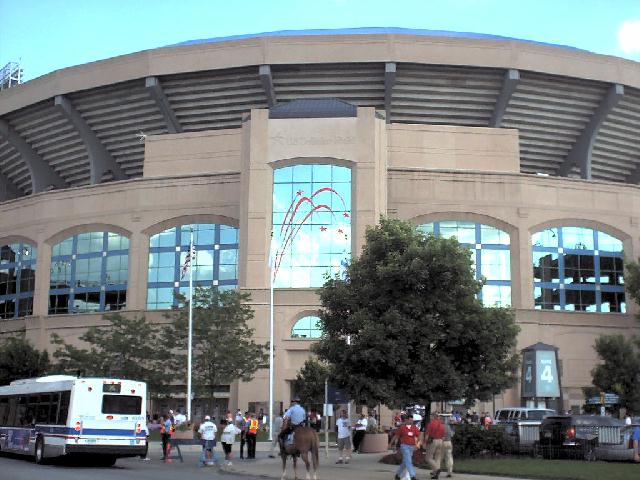 - -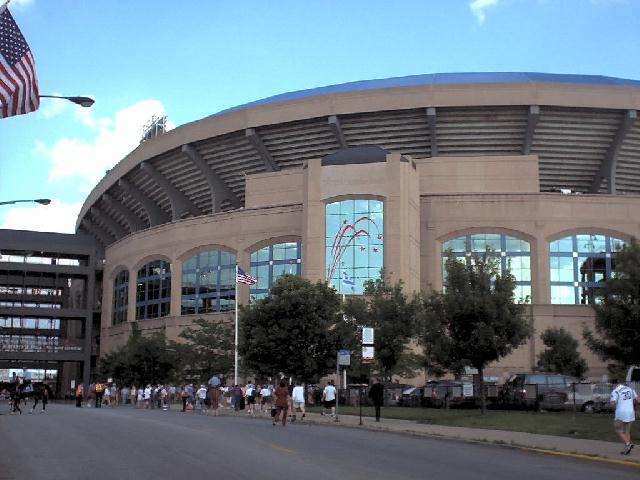 - -
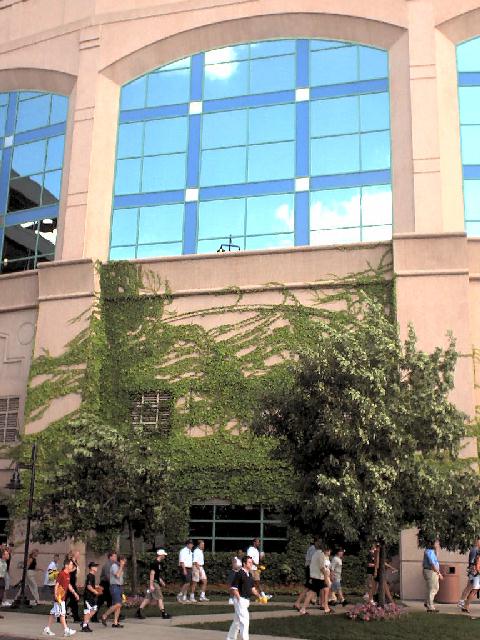 - -
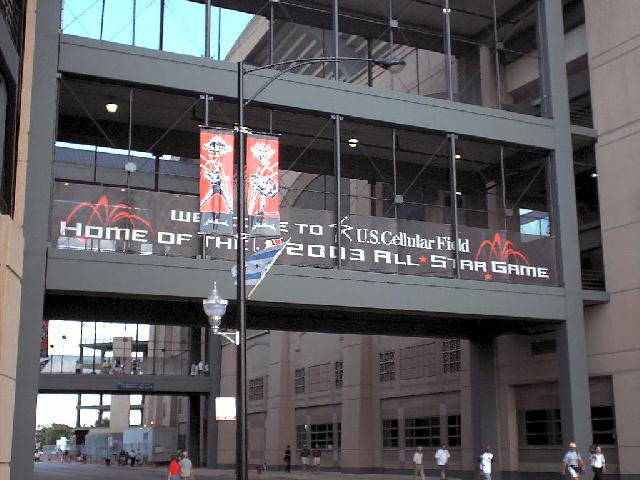

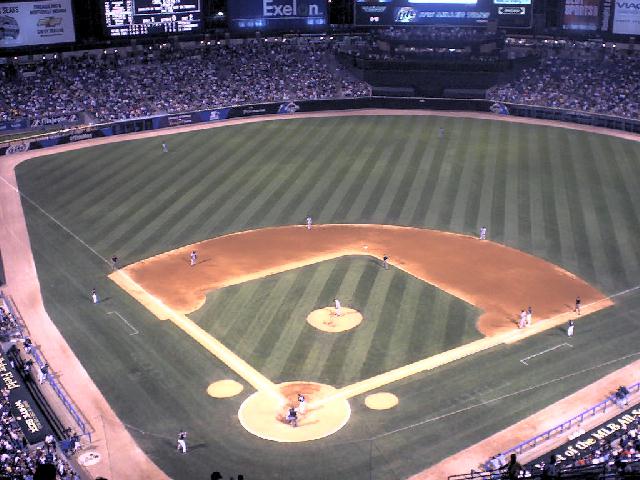
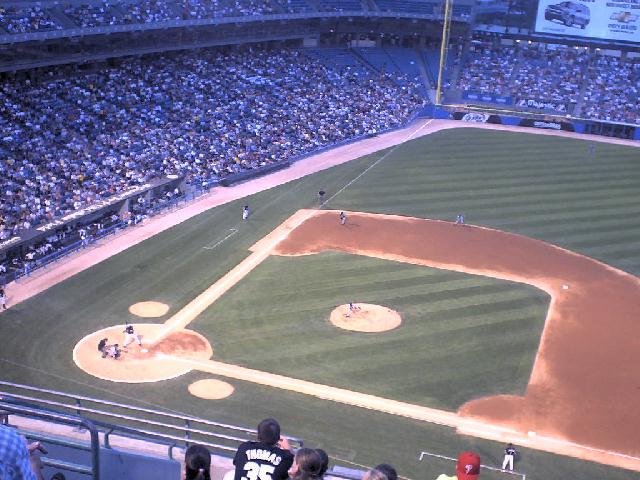
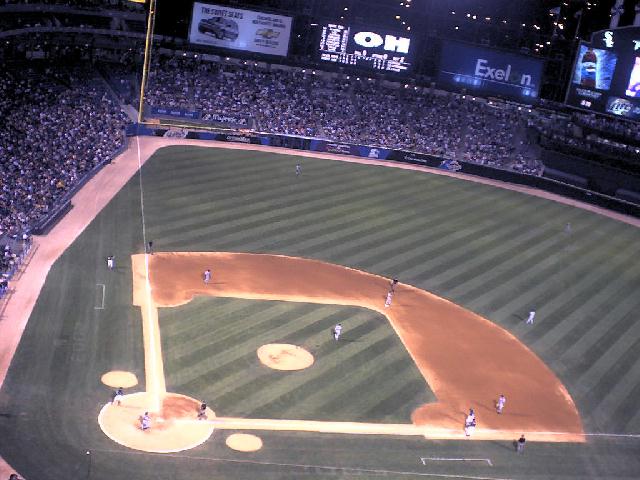


Exterior shots taken on the day of the 2003 All-Star Game. Interior shots taken during game v. Devil Rays, in which Frank Thomas hit his 400th home run.
2003 NB |
|
New
Comiskey | Old Comiskey | Comiskey Park
Timeline
When
it was finished in 1991, the new Comiskey Park peered over the roof
of the old one, scornfully, it seemed--a manifestation of the contempt
White Sox management had for their current stadium. The new facility was
everything the old one wasn't--spacious, clean, and laced with plenty of
luxury boxes. But the dissimilarities didn't end there. While the old park
had charm and history, the new one looked artificial and disposable. The
old park let you feel close enough to the players to hear them cuss; the
new park--whose front row seat in the upper deck was farther from the field
than the last row of the old park--was a vast chasm ("like looking into
a pit," one fan told the Chicago Tribune). Most importantly, the
old park was an integral part of Armour Square, its neighborhood on the
South Side. The new stadium, which now sits in an urban desert of parking
lots, plainly wants nothing to do with those who can see it from their
front porches. If it did, White Sox management would have gone about planning
the new Comiskey much differently. Instead, the new stadium's history is
a sorry tale.
Many people
forget that back in 1984, before the franchise's infamous flirtation with
St. Petersburg, the White Sox had purchased a 140-acre site in Addison
(the suburb, that is, not the street the Cubs play on), and applied for
a government bond to build a new stadium there. The Sox wanted out of the
South Side. Once, White Sox players had been kindred spirits with their
working class neighborhood fans; by the mid-1980s, the team "felt ... exiled
in an unfriendly setting," write Larry Bennett and Costas Spirou in It's
Hardly Sportin': Stadiums, Neighborhoods, and the New Chicago. "It
would be part of white flight, but that isn't the reason for the move,"
owner Jerry Reinsdorf told the Chicago Tribune at the time. "The
fans moved away from the South Side. Why can't we?"
But Addison
didn't want big-league ball in its backyard, and in December of 1986 the
White Sox made a deal with the state of Illinois for a $120 million new
stadium on 35th Street, across from the old Comiskey, funded by taxpayers.
All seemed well. But in 1987, as the state and the city fought for control
of the paperwork on the project, the team started glancing seductively
at the city of St. Petersburg, Florida, which was building its Suncoast
Dome and needed a reason to fill it. By early 1988, local government's
wrangling over the Chicago project worsened, delaying the opening of the
stadium from Opening Day 1990 to 1991, and the White Sox were swooning
over St. Pete, which was offering succulent rental rates for the Suncoast.
The franchise went back to the city of Chicago and demanded a better deal
or they would pack their bags.
I was eight
at the time, and I remember seeing television highlights of players hitting
fly balls in the Suncoast Dome to see if the ceiling was high enough for
big league ball. Back in Chicago, the idea of losing a civic institution
to a small Sun Belt city was revolting. The media blasted the government
for failing to sign a new stadium deal for the White Sox and endangering
their future in town, momentarily forgetting that the White Sox already
had a deal to stay in Chicago. Finally, in a midnight session in June
of 1988, the Illinois legislature agreed to a new stadium deal. Taxpayers
would now pay $150 million for the new park, not $120 million, and the
government would agree to cancel the team's rent and pay for a few hundred
thousand tickets if attendance fell to 1 million people per year. The White
Sox would stay put after all. Former Sox executives have since said the
team was never serious about moving. They just wanted to shake down the
state for more money.
Because of
the political climate of the new stadium's origins--the city's political
tussles, the team's threat to migrate South, and the fact that the Cubs
were generating another controversy on the North Side with their plans
to put lights on Wrigley Field--a lot of things that should have happened
didn't. Armour Square residents weren't given a serious chance to voice
their opinions about the where the new stadium should go and how they would
be compensated for relocating. An intriguing idea from the organization
Save Our Sox, which called for the restoration of the old Comiskey as a
national monument and historic tourist site, failed to win support as the
panicking city and fans looked for a simpler solution. The same was true
of Armour Field, a plan by New Urbanist architect Philip Bess for a more
thoughtfully designed "urban ballpark," which would lie just north of the
old one and would actually interact with its surroundings, as does Wrigley
Field.
As Bennett
and Spirou put it in their book:
Both the ...
proposals aimed to tie stadium development to the adjoining neighborhoods'
long-standing identity. In each case, advocates sought to present major-league
baseball in a physical setting that matched their particular sense of tradition.
Each of these alternative proposals viewed a professional sporting facility
as an institution whose character could be enhanced by and, in turn, could
enhance its local neighborhood enivironment. Such thinking clearly did
not loom large in the minds of White Sox and [government] executives.
Instead, the
Sox wanted and got a truly "suburban" structure, a plastic-looking, self-contained,
parking-lot-skirted, vacuous stadium with little originality and not a
drop of timelessness.
The
greatest travesty of the new Comiskey is how it deliberately fails to embrace
its neighbors despite being built with their tax dollars. The whole point
of having the government pay for the new stadium--at least originally,
before the government was held at gunpoint and just wanted to keep the
team in town--was that the stadium would enrich what had become an impoverished
area by creating jobs and street life. Bars, other businesses, and apartments
could have been built around the park (as Bess' design specifically called
for), turning the area into an actual place, not just a location. Local
residents could have lived and made a living in the park's shadow. It could
have been the South Side's answer to the Wrigley Field's Waveland and Sheffield
streets. But what did the White Sox do? They put a clause in their stadium
deal that no businesses could operate in proxmity to the park. A restraining
order. A clause that prevented the exact economic boost they promised.
As a result,
"Comiskey Park has clearly not set off streams of auxiliary economic development,"
write Bennett and Spirou. In fact, the authors found that the area actually
lost jobs in the six years after the stadium opened. "It is also evident
that the new ballpark has not contributed to upgrading its immediate environment."
In one final
symbolic insult, which Bennett and Spirou document with palpable disgust,
the franchise refused to build around or relocate McCuddy's Tavern--which
stood across from the old park, and to which, as the story went, Babe Ruth
used to sprint between innings for a quick brew (the pub proudly displayed
a piece of carpet he was said to have torn with his cleats). It took an
hour to tear McCuddy's down."The fate of McCuddy's," the authors write,
encapsulates the broader failure to link stadium development and effective
community development in the new Comiskey Park project."
The message
was clear. This will be a stadium you drive to, park around, get in, get
relieved of your money, and get back out again. This will not be a vital
environment. This will be a disconnected destination. That's why it's so
aggravating to read at
WhiteSox.com that the franchise is "part of a uniquely historic Chicago
neighborhood filled with excellent eating and drinking establishments.
In and around [sponsored stadium name], fans are treated to great food
and good times at some of the finest restaurants and bars in the city."
Their consistent approach to, or reproach of, the community has made any
talk from the White Sox franchise of "community relations" pure crap, brown
and sticky. They had their chance, and the result is this forbidding monstrosity.
In an interiew
with Bennett and Spirou in the Chicago Tribune, I asked them if it was
too late for the team to make a meaningful connection with its neighbors.
It was not, they said (the team could start by letting some businesses
open on the same block). But, said Bennett, "Ultimately I don't think Jerry
Reinsdorf wants that."
And, some might
wonder, why should he? As principal architect Rick deFlon, who gets defensive
about complaints of the park's desultory design (and whose firm ironically
went on to design beautiful neighborhood-friendly ballparks in Baltimore
and Cleveland), said; "I'm a dinky little stadium architect. I'm not trying
to design cities." But the Chicago Tribune's Blair Kamin aptly responds:
"It isn't asking too much for a taxpayer-financed public works project
to being healing the city's wounds."
In 2003, one
final link to history was severed; the franchise sold the naming rights
for Comiskey Park to a cell phone company. But they're not paying me anything
to say the new name, so I won't.
UPDATE: After the 2003 season, the White Sox embarked on a $28 million renovation of their ballpark with the intention of making the upper deck more fan-friendly.
Wrote Blair Kamin: "Now, 12 years later, it is remarkable to see a publicly funded stadium that cost nearly $135 million being ripped apart to make it resemble the ballpark it should have been in the first place."
|
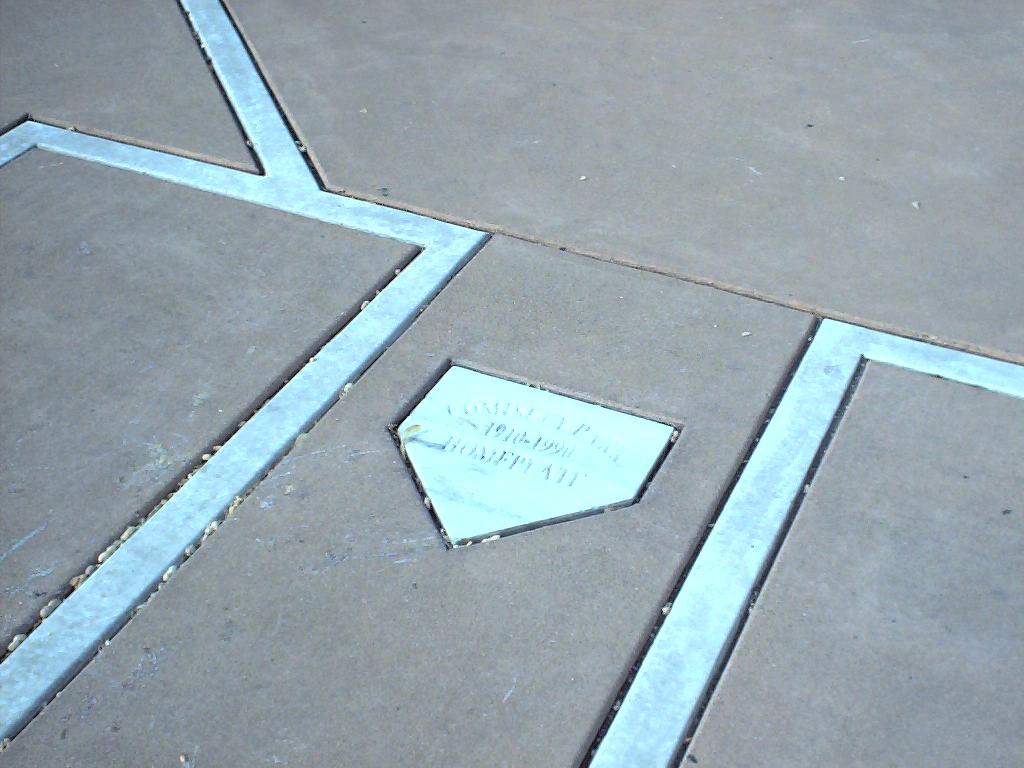
 - -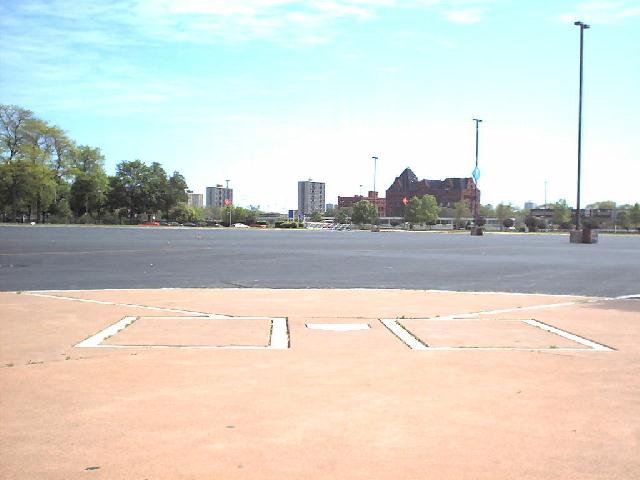
 - -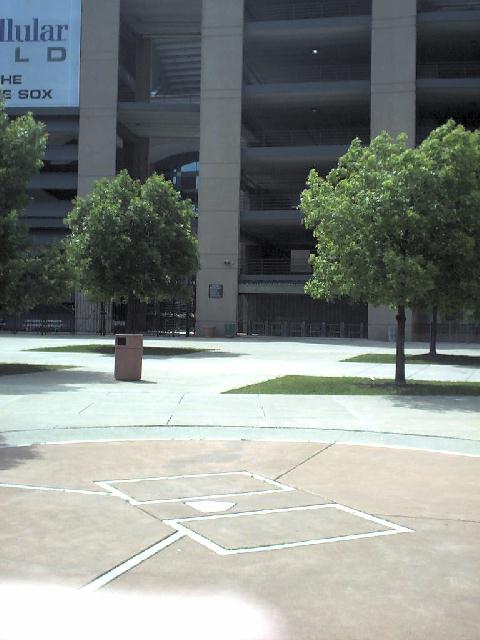 - -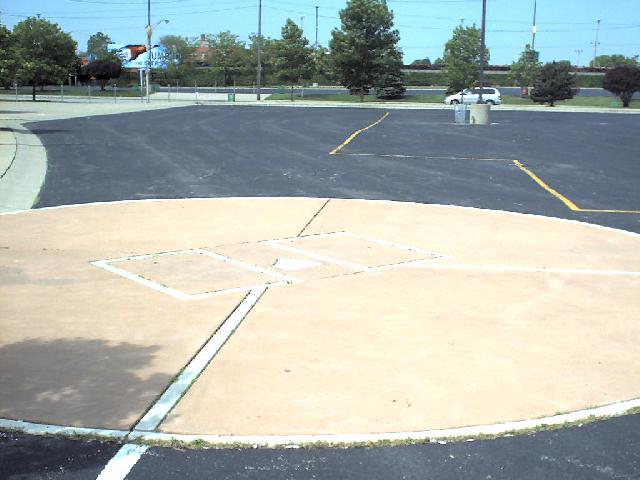
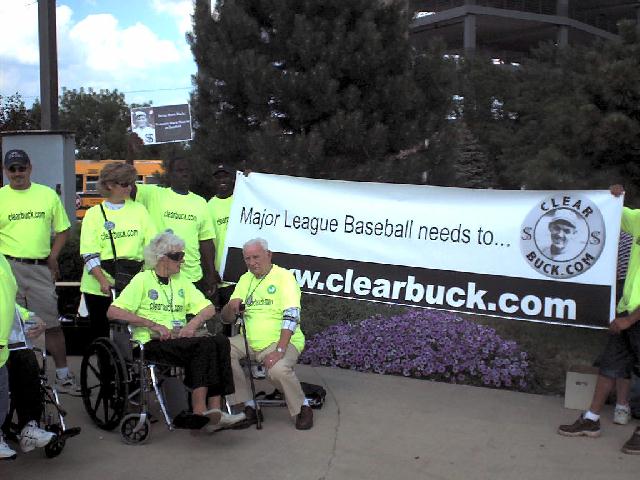
2003 NB
|
|
Old Comiskey
Park
Of
Chicago's two most famous ballparks, the old Comiskey and Wrigley Field--which
were both designed by Zachary Taylor Davis--you could argue that Comiskey
was a fitter icon of the city's history. Only Comiskey exhibited Chicago's
working class heritage, planted as it was in a workaday neighborhood. Before
the age of millionaire athletes, the gritty players provided fans with
relevant heroes (and the team's miserly owner, Charles Comiskey, nonetheless
provided them with cheap bleacher seats). Only in Comiskey could you smell
the stockyards. Only in Comiskey could you regularly see the first Mayor
Daley in his box seat.
Towards the
end of its life Comiskey surrendered its dignity to the gimmicks of eccentric
owner Bill Veeck. Among the earliest was the scoreboard that, back in 1959,
was rigged to launch fireworks after White Sox home runs (a tradition that
continues in the new park). The most infamous was Disco Demolition Night
in the summer of 1979. Fans could get in for under a buck if they brought
a disco record to contribute to a bonfire. But when the fire was lit the
crowd rushed the field and made such a mess that the White Sox had to forfeit
the second game of a doubleheader.
One oddity
of baseball lore is that although the White Sox have one of the longest
championship droughts in sports, you hardly ever hear about it. The Cubs'
famous futility--and their curse of the Billy Goat--and the Boston Red Sox' woes--and
their curse of the Bambino--are much more legendary, even though the White
Sox haven't won the World Series since 1917 (the Cubs last won in 1908
and the Red Sox in 1918). Perhaps this is because the White Sox had their chance in 1919, when they were favored but threw the World Series. No Sox team has won since. Call it the curse of the Black Sox.
Today, all
that is left of the old Comiskey is the batter's box and home plate etched
in the middle of a parking lot across from the new park. Painted foul lines
stretch the length of the former field. The Chicago Tribune wrote
that putting a parking lot on the site of the old Chicago Stadium ensured
"a future of oil leaks where legends once cavorted." The same is true of
the old Comiskey. Today, idle sedans and SUV's from the suburbs drip on
this hallowed ground where 80 years of baseball history (see below)
happened.
Blair Kamin:
The old park
wasn't pretty, but when you plopped down in one of its green wooden seats,
you felt close enough to the field that you could reach out and touch home
plate, smell the turf, and hear what was going on when the catcher, pitcher,
and manager conferred on the mound. And you knew you couldn't be anywhere
else. ... The real test of a ballpark is how well it lets fans taste the
flavor of baseball. It's a game of nuances--the pop of a fastball in the
catcher's mitt versus the soft thud of an off-speed pitch--so it thrives
on intimacy.
-from Why
Architecture Matters |
|
|
Comiskey
Park Timeline
July 1,
1910
White Sox
Park opens; owner Charles Comiskey pronounces it "baseball palace of the
world."
October
13, 1917
White Sox
beat the New York Giants 8-5
to go up three games to two in the World Series. Two days later they win
in New York to clinch the championship, their second ever and last to this
day.
September
5, 1918
Playing at
Comiskey, the Chicago Cubs lose to Boston in Game
1 of the World Series.
October
9, 1919
White Sox
lose Game 8 of the World Series 10-5
to the visiting Cincinnati Reds to drop the series five games to three.
Two years later, jury acquits eight "Black Sox" players of throwing the
series, but Commissioner Landis bans them from baseball for life.
July 6,
1933
First Major
League All Star Game created by the Chicago Tribune to coincide with Chicago's
World's Fair. Babe Ruth hits two-run homer to lift the American League
to a 4-2 win.
Sept. 10,
1933
First
Negro League All-Star Game.
June 22,
1937
Joe
Louis defeats James Braddock for his first heavyweight title.
July 5,
1947
Larry Doby,
pinch hitting for the visiting Cleveland Indians, becomes the first African
American to play in the American League.
Dec. 28,
1947
Wearing tennis
shoes for traction on the slippery field, the Chicago (now Arizona)
Cardinals defeat the Philadelphia Eagles 28-21 for their
only NFL championship.
July 11,
1950
In the first
extra-inning All-Star Game, Ted Williams' fifth inning RBI single gives
the American League the lead (the National League went on to win 4-3 in
14 innings). After the game Williams learned that he broke his left elbow
in the first inning while crashing into the outfield wall for a catch.
May 1,
1951
Minnie Minoso
becomes the first African American to play for the White Sox. In his first
at bat, he hits a home run.
September
25, 1962
Sonny
Liston knocks out Floyd Patterson to win his first heavyweight title.
August
20, 1965
The
Beatles perform two concerts, their only outdoor appearances in Chicago
July 12,
1979
Disco Demolition
night turns riotous, leading to a White Sox forfeit of the second game
of a doubleheader
Sep 22,
1981
Chicago
Sting defeat the San Diego Sockers to advance to the finals of of the
North American Soccer League.
July 6,
1983
Angels' Fred
Lynn hits first-ever All Star Game Grand Slam to lead the American League
to a 13-3 victory.
New Comiskey:
April 9,
1993
Bo Jackson
becomes the first player in history to play with an artificial hip. He
knocks his first pitch out of the park.
July 15,
1994
During a game,
Cleveland Indians pitcher Jason Grimsley breaks into umpires' dressing
room and removes
teammate Albert Belle's confiscated corked bat. He replaces the bat
with one that--alas--bears the name of teammate Paul Sorrento.
August
12, 1994
With the White
Sox in first place, major league players go on a season-ending strike.
Sox owner Jerry Reinsdorf is perceived to be instrumental in prompting
the players' strike.
June 16,
1997
White Sox
host Cubs in first-ever regular season meeting, lose 8-3 before taking
the next two games.
Sept. 28,
1997
Frank Thomas
finishes season with .347 average, becoming the second Sox player ever
to win the American League batting title.
July 15,
2003
American League
wins All-Star Game 7-6;
first time the game decides home field advantage in the World Series.
See also:
-It's
Hardly Sportin': Stadiums, Neighborhoods, and the New Chicago by
Larry Bennett and Costas Spirou
-My interview
with the authors: "Are Chicago's professional sports stadiums good neighbors?"
Chicago
Tribune, April 17, 2003
-"Take me
out to (and in) the ballparks," Lou Carlozo, Chicago Tribune, July
18, 2003
-"[Comiskey]
all aglow, but poverty in shadows," John McCormick, Chicago Tribune,
July 13, 2003
-More
about New Comiskey from Ballparks.com
-Picture
of New Comiskey from Ballparks.com
-More
about New Comiskey from WhiteSox.com
-More
about New Comiskey from BallparksofBaseball.com
-More
about Old Comiskey from Ballparks.com
-More
about Old Comiskey from WhiteSoxInteractive.com
-Pictures
of Old Comiskey from WhiteSoxInteractive.com
-Pictures
of Old Comiskey from StadiumPage.com
-1991
picture of the two adjacent Comiskey Parks from Ballparks.com
-History
of both Comiskey Parks from WhiteSox.com
-Team
timeline from WhiteSox.com
-More
about the Black Sox from the Chicago HIstorical Society
-More
about the Black Sox trial from Famous Trials Online
-Chicago
White Sox all-time stats from Baseball-Reference.com |
|
|